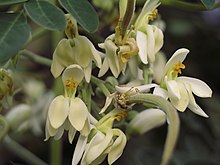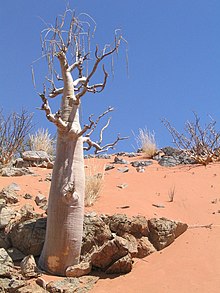Moringa
| Moringa | ||||||||||||
|---|---|---|---|---|---|---|---|---|---|---|---|---|

Moringa ovalifolia in Namibia |
||||||||||||
| Systematics | ||||||||||||
|
||||||||||||
| Scientific name of the family | ||||||||||||
| Moringaceae | ||||||||||||
| Martinov | ||||||||||||
| Scientific name of the genus | ||||||||||||
| Moringa | ||||||||||||
| Adans. |


Moringa is the only genus of the monogeneric family of the Bennuss family (Moringaceae). The botanical name of the genus comes from the name commonly used in southern India for the species Moringa oleifera ( Malayalam : മുരിങ്ങ muriṅṅa, Tamil : முருங்கை muruṅkai ).
description
The species of this genus are deciduous small shrubs or trees with succulent , bulbous or fleshy roots or "bottle trees" with succulent, swollen trunks. In their succulent parts in particular, they contain mustard oil glycosides , which have a strong smell of horseradish . The shrub-like species sometimes have very few branches that dry out in periods of drought. In periods of damp, they sprout again from the storage roots with rapid growth. The alternately arranged, stalked leaves are double or triple pinnate, with entire , mostly small partial leaves. Stipules are absent or sometimes form stalked glands on the bases of the petioles and partial leaves.
Many flowers stand together in axillary, paniculate or zymous inflorescences . The hermaphrodite , five-fold flowers are very small to strongly zygomorphic . The flower cup is cup-shaped or tubular. The five sepals are partly unequal. Of the five unequal white, yellow or red petals , the one on the outside is usually the largest. There are three to five staminodes between the five free, fertile stamens . Two to four carpels are a top permanent to half under constant, pedunculated and cylindrical ovary adherent having a slender, tubular stylus without scars beam carries.
The woody, three- to twelve-edged capsule fruit consists of three flaps that tear open when ripe (explosively). The numerous, mostly (with three wings) winged seeds do not contain any nutrient tissue ( endosperm ).
Systematics and distribution
The plant family is very small with one genus and 13 species. Closer related are the cruciferous plants (Brassicaceae) and, as was only revealed by DNA analysis , the caper plants (Capparaceae).
Due to the structure of the flowers, the genus is divided into three sections:
- Moringa section with a short flower cup and half-underneath ovary,
- Section Donaldsonia ( Baker f. ) Verdc. - with short flower cup and ovary above and
- Section Dysmoringa ( Engl. ) - with long-tubular flower cup and half-underneath ovary.
The natural range of the family and genus extends from India over the Arabian Peninsula to the main focus in East Africa and with a gap to Madagascar and southwest Africa .
species
- Moringa arborea Verdc. : a little-known slender tree in northeastern Kenya .
- Moringa borziana Mattei : a shrub up to 1 m tall with a few twigs and a large (up to 1.5 m diameter), succulent beet root, widespread from southeast Kenya to southeast Somalia .
- Moringa concanensis Nimmo : a slender tree with up to 15 cm thick bark, distributed from southeastern Pakistan via India to Bangladesh .
- Moringa drouhardii Jum. : a 5 to 10 m high, succulent tree with a strongly bottle-shaped thickened trunk, native to southern Madagascar , very similar in shape to the African Adansonia digitata .
- Moringa hildebrandtii Engl .: A succulent tree up to 25 m high with a strongly bottle-shaped thickened trunk, native to southwestern Madagascar, in other parts of Madagascar mostly planted near royal graves.
- Moringa longituba Engl .: A shrub up to 50 cm high with mostly only one branch and a succulent beet root, distributed from southeast Kenya via Somalia to southeast Ethiopia .
- Horseradish tree ( Moringa oleifera Lam. ): From north-western India.
- Moringa ovalifolia Dinter & A. Berger : a 2 to 6 m high, succulent tree with a strongly bottle-shaped thickened trunk, native to Namibia and southwestern Angola .
- Moringa peregrina Fiori : a slender tree or sometimes a shrub with a succulent beet root, also with succulent branches when young, spread around the Red Sea ( Arabian Peninsula as far as Somalia).
- Moringa pygmaea Verdc. : a small shrub with a succulent beet root, known only from two specimens from northern Somalia and has not yet been found.
- Moringa rivae Chiov. : a shrub up to 3 m tall and a succulent beet root, native to Kenya and Ethiopia.
- Moringa ruspoliana Engl .: A slender tree up to 6 m high with very large partial leaves, succulent beet roots and, with age, strongly thickened root system, native from northern Somalia via southeastern Ethiopia to the border with Kenya.
- Moringa stenopetala ( Baker f. ) Cufod. : a succulent tree up to 10 m high with a bottle-shaped thickened trunk, native to Ethiopia and Kenya.
Bernard Verdcourt reports on another succulent, not yet described species, which is probably related to Moringa longituba .
Moringas as useful and ornamental plants
The seeds of Moringa oleifera provide the behen oil that was previously used as a lubricant in watches . Today it is used as salad oil or for making soaps and cosmetics . The young, fleshy roots are sometimes used as vegetables . Species that can be quickly grown as cuttings are planted in Africa as border markings for houses or farms. The succulent species are rare and sought-after collector's items by enthusiasts.
The leaves of the Moringa tree contain all essential amino acids and fatty acids as well as a wide range of vitamins and minerals. Moringa has been grown on Tenerife since 2012 and products made from the plant are offered.
Another application makes use of the ability of the seeds to disinfect or purify water. With 0.2 g of ground moringa seeds, 1 liter of contaminated water can be made drinkable. The water-purifying effect of Moringa is mainly based on the coagulating effect of some of the ingredients in the seeds. The bacteria and suspended matter combine to form agglomerates, so that they sink to the bottom or can be filtered off. However, there are also direct bactericidal properties of the ingredients of the seeds.
A study by the London School of Hygiene and Tropical Medicine concluded that an amount of 4 g of dried powder or an equivalent aqueous preparation made from ground Moringa leaves is as effective at washing hands (hands were previously contaminated with Escherichia coli ) as around 3 g of a standard soap according to EN 1499.
swell
- The Moringaceae the family in APWebsite (English)
- Description of the Moringaceae family at DELTA. (English)
literature
- Michel Adanson : Moringaceae , Familles des Plantes 2: 318, 1763.
- Monique Keraudren: Famille 85: Moringacées . In: Jean-Henri Humbert & Jean-François Leroy (eds.): Flore des Madagascar et des Comores , Muséum National d'Historie Naturelle: 33–44, 1982.
- Ian Keith Ferguson: The pollen morphology of Moringaceae , Kew. Bull. 40 (1): 25-34, 1985.
- M. Fernanda Pinto Basto: Flora de Cabo Verde, plantas vasculares - 37. MORINGACEAE , 1995, ISBN 972-672-783-9
- Mark Earl Olson: Intergeneric Relationships within the Caricaceae-Moringaceae Clade (Brassicales) and Potential Morphological Synapomorphies of the Clade and Its Families , International Journal of Plant Sciences, 163: 51-65, 2002.
- Mark Earl Olson: Combining data from DNA sequences and morphology for a phylogeny of Moringaceae (Brassicales) , Syst. Bot. 27: 55-73, 2002.
- Mark Earl Olson: Ontogenetic origins of floral bilateral symmetry in Moringaceae (Brassicales) . American J. Bot. 90: 49-71, 2003.
- Erwin G. Bruhns: "The miracle tree Moringa", ISBN 978-3-9812259-1-4
Individual evidence
- ↑ Mark Earl Olson: Intergeneric relationships within the Caricaceae-Moringaceae clade (Brassicales) and potential morphological synapomorphies of the clade and its families . In: International Journal of Plant Sciences . Volume 163, 2002, pp. 51-65.
- ^ Bernard Verdcourt: A synopsis of the Moringaceae , Kew. Bull. 40 (1): 1-23, 1985
- ^ Bernard Verdcourt: Moringaceae . In: Roger Marcus Polhill (ed.): Flora of Tropical East Africa , Rotterdam (NL) / Brookfield (US: VT): AA Balkema, 1986
- ↑ Moringa project: Environmentally friendly drinking water treatment through the use of seeds from the Moringa oleifera / horseradish tree. German Federal Environment Foundation , final report April 30, 2014.
- ↑ Moringa: The Science Behind the Wonder Tree. Science in School, September 9, 2013.
- ↑ Eilert U. et al. (1981): The Antibiotic Principle of Seeds of Moringa oleifera and Moringa stenopetala Journal of Medicinal Plant Research 42: 55-61
- ↑ Efficacy of Moringa oleifera leaf powder as a hand-washing product: a crossover controlled study among healthy volunteers Four grams of Moringa oleifera powder in dried and wet application had the same effect as non-medicated soap when used for hand washing.

